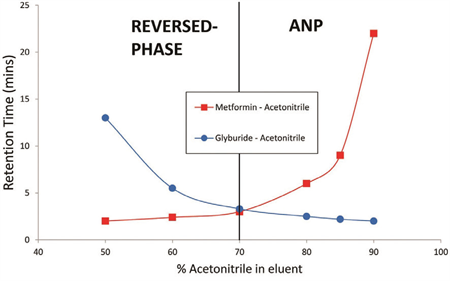- Compared to ANP, HILIC will require more time to equilibrate between gradient runs
- HILIC takes more salt to retain some compounds.
- HILIC often lacks retention time RT precision.
- HILIC cannot retain polar compounds with high amounts of water in the mobile phase.
- Lifetime of the HILIC columns can be very short but silica hydride columns are robust.
- Mobile phase used in ANP can be the same used in RP and not need a HILIC mobile phase.
With Cogent TYPE-C columns (silica hydride particles) using ANP, equilibration is extremely fast, retention time (RT) precision is extraordinarily good, and columns can last up to 10x longer. Also, silica hydride columns can retain Polar and some Non-polar Compounds in the same run.
It has been reported over the years that to equilibrate a HILIC column, you should allow 5 minutes per every 5 cm of column length plus 2 minutes for hold and 5 more minutes of run before you start the injection. With ANP methods, you need a total of about 7 minutes to achieve precision on the same instrument and column length.
NOTE: TYPE-C columns can be used for Reversed Phase or Normal Phase mode as well as ANP. Use typical method development strategy when using these columns in RP or ONP modes but expect different retention times, selectivity as these columns can be orthogonal to ordinary columns.
Cogent TYPE-C Silica stationary phases have the ability to retain Polar solutes at high concentrations of the organic component while maintaining an aqueous component in the mobile phase utilizing the ANP retention mechanism. All of the Cogent TYPE-C phases possess this capability including C8 and C18. The exact composition of the mobile phase where Aqueous Normal Phase ANP retention begins depends on the solute as well as the stationary phase selected. Because of the attached organic group that is part of the stationary phase, the TYPE-C columns can also retain nonpolar compounds based on the typical reversed phase mechanisms. The diagram below illustrates how this dual retention capability works for both polar (metformin) and nonpolar (glyburide) compounds:
A Generic Method - Starting Point for Cogent TYPE-C Columns
It is easy to use a Cogent™ HPLC column that is made with TYPE-C Silica™.
Step 2: Equilibrate (Reversed Phase). Run about 6 column volumes of the mobile phase in Step 1 at 95% water.
Step 3: Reversed Phase Gradient. Set up your instrument to run a shallow gradient from 95% water to 40% water for 20 minutes. This long and shallow gradient will be very beneficial for determining the optimal gradient or isocratic method to run your mixture with later. For sharper peaks and less retention, run a shorter (Steeper) gradient from the same starting points to end points.
Step 4: Equilibrate (ANP). Equilibrate the column by running 100% acetonitrile for approximately 2 minutes.
Step 5: ANP Gradient. Set up your instrument to run a shallow gradient using the same mobile phase in Step 3 to run from 90% acetonitrile to 40% acetonitrile for 20 minutes. This long and shallow gradient will be very beneficial for determining the optimal gradient or isocratic method to run your mixture with later. For sharper peaks and less retention, run a shorter (steeper) gradient from the same starting points to end points.
Step 6: Compare the Reversed Phase and ANP Data. Evaluate both gradient runs for retention time, peak shape and elution order as retention on the column is compound specific where some compounds will not retain in Step 3 (Reverse Phase) and some do not retain in Step 5 (Aqueous Normal Phase). One column could produce an isocratic run which retains both polar and non-polar compounds.
Note: The Cogent Bidentate C8 and C18 columns have a unique quality in that they sometimes can retain polar compounds not retained on other columns while run at 100% water. You could insert an isocratic run at 100% water after Step 3 and before Step 4.
The power of these columns is found in the wide range of solvents that can be used with them and the unique and strong retention they can have for polar compounds while at the same time retaining nonpolar compounds. Selection of the column (Diamond Hydride, Phenyl Hydride, Amide, C18, C8, Cholesterol or Silica-C™ etal) will be determined by your compounds of interest. Mixtures that will be highly polar and do not contain nonpolar compounds might be better suited by the Diamond Hydride where compounds with both polar and nonpolar might be better suited to the Bidentate C18.

Attachment:
COGENT TYPE-C Quick Start Guide Download File

